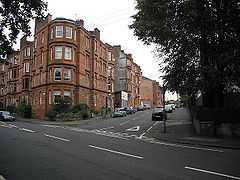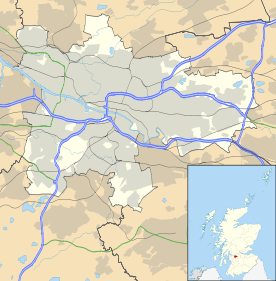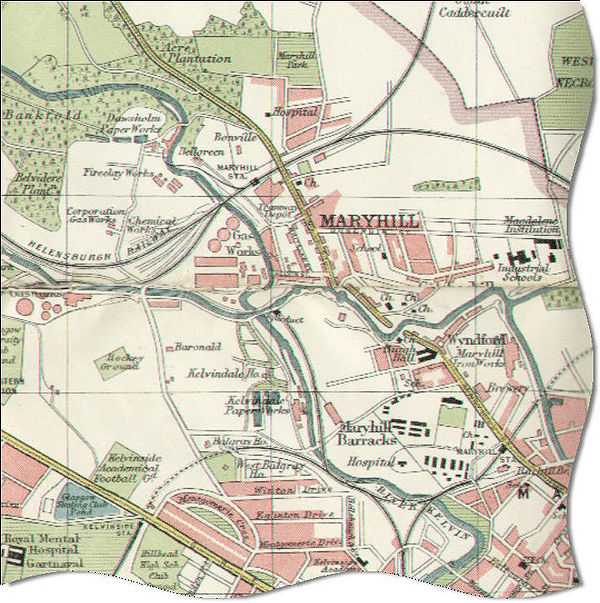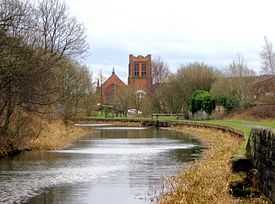Maryhill
| Maryhill | |
| Scottish Gaelic: Cnoc Mhoire | |
| Scots: Maryhull | |
 Shakespeare Street |
|
 Maryhill |
|
| OS grid reference | NS563691 |
|---|---|
| Council area | City of Glasgow |
| Lieutenancy area | Glasgow |
| Country | Scotland |
| Sovereign state | United Kingdom |
| Post town | GLASGOW |
| Postcode district | G20 |
| Dialling code | 0141 |
| Police | Scottish |
| Fire | Scottish |
| Ambulance | Scottish |
| EU Parliament | Scotland |
| UK Parliament | Glasgow North |
| Scottish Parliament | Glasgow Maryhill and Springburn |
Coordinates: 55°53′39″N 4°17′40″W / 55.8941°N 4.2944°W
Maryhill (Scots: Maryhull, Scottish Gaelic: Cnoc Mhoire)[1] is an area of the City of Glasgow in Scotland. Maryhill is a former burgh. The population of Maryhill is about 52,000. Maryhill stretches over 7 miles (11 km) along Maryhill Road. Several sub-districts belong to the Maryhill district, such as Acre, Dawsholm Park, Firhill, Gairbraid, Gilshochill, Maryhill Park, North Kelvinside, Queen's Cross, St George's Cross, Cadder (Glasgow),
Summerston, Woodside and Wyndford.
The far north west of the area is served by Maryhill railway station.
History

Hew Hill, the Laird, or Lord, of Gairbraid, had no male heir and so he left his estate to his daughter, Mary Hill (1730-1809). She married Robert Graham of Dawsholm in 1763, but they had no income from trade or commerce and had to make what they could from the estate. They founded coalmines on the estate but they proved to be wet and unprofitable, and their property ventures are best known for an acre of ground they did not sell. It is still known as Acre today.
No doubt they would have continued with the struggle, but on the 8 March 1768 Parliament approved the cutting of the Forth and Clyde Canal through their estate, which provided some much-needed money. The canal reached the estate in 1775, but the canal company had run out of money and work stopped for eight years. The Government granted funds from forfeited Jacobite estates to start it again and the crossing of the River Kelvin became the focus for massive construction activity. Five locks, the great Kelvin Aqueduct and, between two of the locks, a dry dock boatyard were built. A village too began to grow up and the Grahams fed more land for its development; Robert Graham attached one condition that was to immortalise the heiress of Gairbraid, his beloved wife and the last in line of centuries of Hills of Gairbraid after the death of her father Hew Hill. The then village was to be "in all times called the town of MaryHill".
The new canal waterway attracted industries including; boat-building, saw-milling and ironfounding to its banks within Mary's estate. By 1830 the scattered houses had grown to form a large village with a population of 3000 people. The building of the Glasgow, Dumbarton and Helensburgh Railway passing through Maryhill in the 1850s, and the proximity of the Loch Katrine pipeline, led to further growth and in 1856 Maryhill became a burgh in its own right. It was later absorbed into the boundaries of the city of Glasgow in 1891.
A part of the Antonine Wall runs through Maryhill, in the Maryhill Park area, where there is the site of a Roman fort adjoining the wall in nearby Bearsden.
Maryhill had the first Temperance Society in the United Kingdom after lawlessness filled the streets in the Victorian era.
Maryhill also boasts one of Glasgow's original Carnegie libraries, deftly designed by the Inverness architect James Robert Rhind.
Maryhill Barracks was opened in 1872 and once dominated the area that is now the Wyndford housing estate. It was home to the Scots Greys and the Highland Light Infantry, and famously held Adolf Hitler's second-in-command Rudolf Hess during World War II after his supposed "peace" flight to the UK. The barracks were decommissioned in the early 1960s. However the Territorial Army unit, the 52nd Lowland, 6th Battalion, the Royal Regiment of Scotland continues to be based at the adjacent Walcheren Barracks. 32 (Scottish) Signal Regiment is also based near Kelvinside, with 105 Regiment, Royal Artillery in nearby Partick.
Maryhill was known as the Venice of the North for its canals and also for being the centre of the glass industry, with its Caledonia Works and Glasgow Works.
Governance
Maryhill is a constituent member of the Scottish Parliament, known as Glasgow Maryhill. Glasgow Maryhill was a constituency represented in the House of Commons of the Parliament of the United Kingdom from 1918 until 2005 when it was subsumed into the new Glasgow North constituency.
Demography
The entire population of the Maryhill area of the city is around 52,000.
The Maryhill area has the largest Chinese community in Scotland and is one of the most multicultural districts of Glasgow.
Economy
Many areas in the north of Glasgow are below the normal UK standard of living. However, not all areas of North Glasgow are in poor condition. Maryhill is in the north west of the city, and consists of well maintained traditionally "Glaswegian" sandstone tenements with the traditional high ceilings as well as many large Victorian town houses. There are also large housing association-run housing estates. Although historically a working class area, it is relatively wealthy compared to the rest of the north of the city, containing a large student population as well as a large number who could be described as middle class..
The district contains the Wyndford and Gairbraid estate, a housing estate with a population of almost 5,000, containing a number of high-rise housing blocks, the highest four reaching heights of 26 storeys. These are intermixed with lower residences to create an estate of significant housing contrast and variety.
The former Lord Provost of Glasgow, Bob Winter, is Maryhill's local councillor. He was elected to the post shortly after the local and national Scottish Election in May 2007.
Sport
Maryhill is home to Firhill Stadium, the home of Scottish Premiership club Partick Thistle since 1909, and was, in 2005-2012, for the professional Rugby Union team, Glasgow Warriors. The junior team, Maryhill F.C. and Glasgow's oldest athletic club (Maryhill Harriers) are also located in Maryhill.
Architecture, canalside and modernisation

Ruchill Church Hall was designed by Charles Rennie Macintosh.
The Forth and Clyde Canal flows through Maryhill, at one stage forming a vital part of the local economy. It was for many years polluted and largely unused after the decline of heavy industry, but recent efforts to regenerate and re-open the canal to navigation have seen it rejuvenated. Along the canalside, from the city centre along into Maryhill: plans for canalside flats, similar to the rejuvenation of old industrial warehouses in Manchester, have been granted.
Twenty unique stained glass windows were produced by Stephen Adam in 1878 for the Maryhill Burgh Halls, depicting the many varied industries and occupations of Maryhill's inhabitants. The Burgh Hall, part of a complex of listed buildings including the former Baths & Wash-houses, the former Fire Station, and former Police Station, is currently being restored in a £9.2M regeneration project, and a number of the original stained glass windows should be on display from late 2011.[2]
Maryhill in the media
Maryhill has been the location for a number of television programmes and films, namely:
- Taggart, an internationally famous Glaswegian detective television programme, which is translated into many languages including German and Japanese is set and filmed in Maryhill. Fans and tourists still come to the Maryhill Police Station to take photographs.
- Trainspotting, A cafe in Maryhill was used as a set in Trainspotting, Jaconelli's at the Queens Cross area.[3] Also, Crosslands on Queen Margaret Drive was the pub where Begbie started a fight by throwing a glass over his head into a crowded bar.[4]
- A short-lived 1960s TV soap High Living created by (then) Cowcaddens-based Scottish Television was set in a tower block in the Wyndford area of Maryhill, however as a totally studio-based drama, it relied of pictures of the flats as part of the opening and closing title sequences.
- The hit BBC television comedy series Chewin' the Fat was filmed in the area, a precedent followed by its successor the sitcom Still Game. They often showed local features including the Forth and Clyde Canal in the background and several other areas and landmarks of Maryhill in outdoor shots.
Notable residents
- Donovan, singer-songwriter
- Sean Biggerstaff, actor
- Robert Carlyle, actor
- Maggie Bell, blues-rock singer
See also
- Forth to Firth Canal Pathway
References
- ↑ List of railway station names in English, Scots and Gaelic – NewsNetScotland
- ↑ "Maryhill Burgh Halls". Maryhill Burgh Halls.
- ↑ http://russelldavies.typepad.com/eggbaconchipsandbeans/2005/04/cafe_djaconelli.html russelldavies.typepad.com
- ↑ http://www.movie-locations.com/movies/t/trainspotting.html movie-locations.com
- ↑ Lyons, Beverley (11 May 2012). "Ross Kemp in Glasgow to report on poverty and crime for new Sky series". Daily Record (Glasgow).
.jpg)